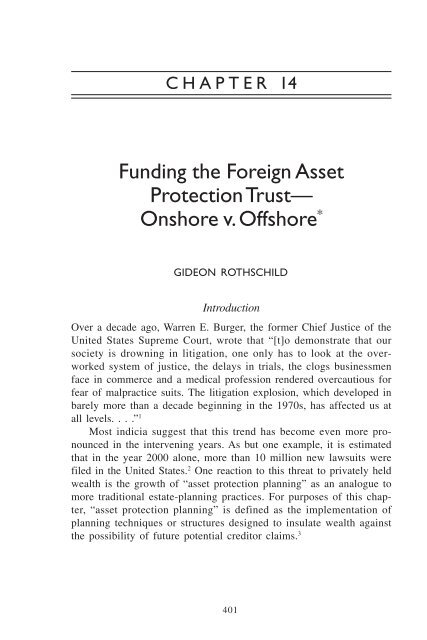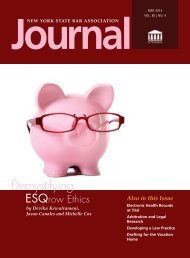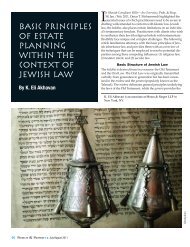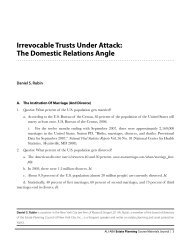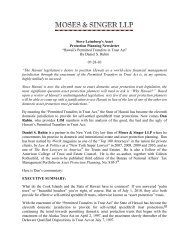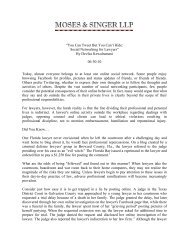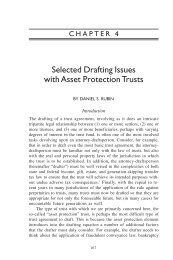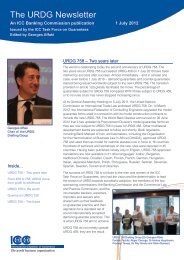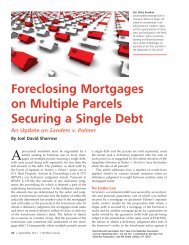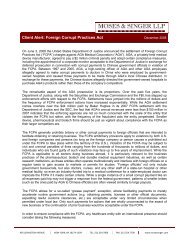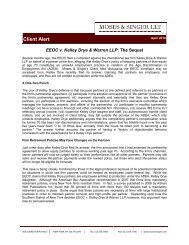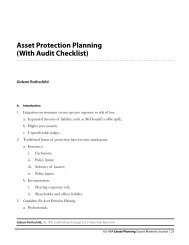Funding the Foreign Asset Protection Trust - Moses & Singer, LLP
Funding the Foreign Asset Protection Trust - Moses & Singer, LLP
Funding the Foreign Asset Protection Trust - Moses & Singer, LLP
You also want an ePaper? Increase the reach of your titles
YUMPU automatically turns print PDFs into web optimized ePapers that Google loves.
CHAPTER 14<br />
<strong>Funding</strong> <strong>the</strong> <strong>Foreign</strong> <strong>Asset</strong><br />
<strong>Protection</strong> <strong>Trust</strong>—<br />
Onshore v. Offshore *<br />
GIDEON ROTHSCHILD<br />
Introduction<br />
Over a decade ago, Warren E. Burger, <strong>the</strong> former Chief Justice of <strong>the</strong><br />
United States Supreme Court, wrote that “[t]o demonstrate that our<br />
society is drowning in litigation, one only has to look at <strong>the</strong> overworked<br />
system of justice, <strong>the</strong> delays in trials, <strong>the</strong> clogs businessmen<br />
face in commerce and a medical profession rendered overcautious for<br />
fear of malpractice suits. The litigation explosion, which developed in<br />
barely more than a decade beginning in <strong>the</strong> 1970s, has affected us at<br />
all levels. . . .” 1<br />
Most indicia suggest that this trend has become even more pronounced<br />
in <strong>the</strong> intervening years. As but one example, it is estimated<br />
that in <strong>the</strong> year 2000 alone, more than 10 million new lawsuits were<br />
filed in <strong>the</strong> United States. 2 One reaction to this threat to privately held<br />
wealth is <strong>the</strong> growth of “asset protection planning” as an analogue to<br />
more traditional estate-planning practices. For purposes of this chapter,<br />
“asset protection planning” is defined as <strong>the</strong> implementation of<br />
planning techniques or structures designed to insulate wealth against<br />
<strong>the</strong> possibility of future potential creditor claims. 3<br />
401
402 CHAPTER FOURTEEN<br />
For a large number of affluent Americans, asset protection planning<br />
has come to include an offshore asset protection trust as an integral<br />
component of <strong>the</strong> plan. The creation of such a trust by a U.S. citizen or<br />
resident takes advantage of a dichotomy between <strong>the</strong> law of most of <strong>the</strong><br />
50 states and <strong>the</strong> law of select foreign jurisdictions. Specifically, certain<br />
foreign jurisdictions permit an individual (a “settlor”) to create a trust<br />
wherein <strong>the</strong> settlor is named as a discretionary beneficiary without<br />
<strong>the</strong>reby subjecting <strong>the</strong> trust fund to <strong>the</strong> settlor’s potential future creditor<br />
claims. By contrast, most domestic jurisdictions provide that, as a public<br />
policy matter, such a “self-settled” trust remains fully available to <strong>the</strong><br />
settlor’s creditors. Significantly, however, under established conflict of<br />
law rules, <strong>the</strong> application of foreign law to a trust created by a United<br />
States person should be valid in any domestic jurisdiction notwithstanding<br />
that such foreign law might be diametrically opposed to local law. 4<br />
“This permits a person who is domiciled in a state in which restraints on<br />
alienation are not permitted to create an inter vivos trust in ano<strong>the</strong>r state<br />
where <strong>the</strong>y are permitted and <strong>the</strong>reby take advantage of <strong>the</strong> law of <strong>the</strong><br />
latter state.” 5 Hence, <strong>the</strong> offshore asset protection trust’s use as a valuable<br />
tool for United States residents to protect wealth from <strong>the</strong> possibility<br />
of potential future creditor claims.<br />
Notwithstanding <strong>the</strong> foregoing, however, an extremely aggressive<br />
plaintiffs’ bar espousing ever-expanding <strong>the</strong>ories of liability, coupled<br />
with a seemingly innate judicial bias against <strong>the</strong> importation of foreign<br />
law, raises a question as to <strong>the</strong> efficacy of offshore asset protection<br />
trusts that are ultimately funded only with “onshore” assets (such<br />
as domestic banks, brokerage accounts or securities) and which thus<br />
remain within <strong>the</strong> ambit of <strong>the</strong> court’s jurisdiction. 6 Is it necessary <strong>the</strong>n<br />
to secure, through <strong>the</strong> establishment of foreign accounts (i.e., an “exporting<br />
<strong>the</strong> assets” approach), a level of protection that ought to be<br />
afforded domestically under established conflict of law rules (i.e., an<br />
“importing” of <strong>the</strong> foreign law) This chapter will examine and resolve<br />
this important asset protection planning question.<br />
Discussion<br />
For many years, offshore asset protection trusts were frequently invested<br />
solely with United States situs assets. Such an arrangement provided<br />
a settlor with a certain level of asset protection, while at <strong>the</strong><br />
same time allowing <strong>the</strong> settlor to continue with <strong>the</strong> comfort and perceived<br />
security of a domestic investment portfolio. In fact, in many
<strong>Funding</strong> <strong>the</strong> <strong>Foreign</strong> <strong>Asset</strong> <strong>Protection</strong> <strong>Trust</strong>—Onshore v. Offshore 403<br />
instances <strong>the</strong> settlor would actually continue to directly control <strong>the</strong><br />
investment portfolio by interposing a domestic limited partnership (in<br />
which <strong>the</strong> settlor was named as <strong>the</strong> general partner) between <strong>the</strong> trust<br />
and <strong>the</strong> investment portfolio. The hope for such trusts was that a domestic<br />
court adjudicating a potential future creditor’s claim would,<br />
under established conflict of law rules, respect <strong>the</strong> validity of <strong>the</strong> designated<br />
foreign governing law. In order to ensure that <strong>the</strong> trust would<br />
protect against creditor claims, however, <strong>the</strong> foreign trustee would<br />
continually evaluate <strong>the</strong> trust settlor’s creditor situation and (likely with<br />
<strong>the</strong> settlor’s assistance) expatriate <strong>the</strong> trust fund if and when it might<br />
become necessary to do so. The effect of <strong>the</strong> trust fund’s timely expatriation<br />
would be to render moot any potential adverse decision by a<br />
domestic court, since offshore asset protection trusts are generally established<br />
in jurisdictions that will not enforce foreign judgments. 7 Additionally,<br />
it was anticipated that an “anti-duress clause” directing <strong>the</strong><br />
foreign trustee to ignore any instruction not given as an act of free will<br />
would insulate <strong>the</strong> settlor under an “impossibility of performance”<br />
defense for failing to effect repatriation of <strong>the</strong> assets following <strong>the</strong><br />
possible issuance of a court order.<br />
Although <strong>the</strong> aforementioned structure does undoubtedly provide<br />
a substantial level of asset protection, four possible issues exist within<br />
such structure which could affect its protectiveness, and which could<br />
be avoided if it were funded from its initial settlement solely with foreign<br />
accounts.<br />
Issue One: The Specter of a Fraudulent Conveyance<br />
The most basic claim against any offshore asset protection trust will<br />
be that <strong>the</strong> settlor’s funding of <strong>the</strong> trust constituted a “fraudulent conveyance.”<br />
Black’s Law Dictionary defines a “fraudulent conveyance”<br />
as a “ . . . transfer of property, <strong>the</strong> object of which is to defraud a<br />
creditor, or hinder or delay him, or to put such property beyond his<br />
reach.” 8 One remedy for a fraudulent conveyance is for <strong>the</strong> court to<br />
void <strong>the</strong> transfer and permit recovery from <strong>the</strong> transferee.<br />
For purposes of this chapter, it is assumed that <strong>the</strong> trust’s initial<br />
settlement was not a fraudulent conveyance because, if it were assumed<br />
o<strong>the</strong>rwise, expatriation of <strong>the</strong> trust fund would arguably be an<br />
illegal act in which <strong>the</strong> trustee would not want to become involved. If,<br />
however, <strong>the</strong> trust fund is initially invested in domestic bank and brokerage<br />
accounts, <strong>the</strong> trustee would likely have no compunction against
404 CHAPTER FOURTEEN<br />
closing out <strong>the</strong> trust’s domestic accounts and transferring <strong>the</strong> assets<br />
<strong>the</strong>reof to foreign institutions if, in consultation with <strong>the</strong> settlor, such<br />
action appears necessary to preserve <strong>the</strong> trust fund from creditors. If<br />
<strong>the</strong> trust fund is invested through a limited partnership in which <strong>the</strong><br />
settlor is <strong>the</strong> general partner, expatriation of <strong>the</strong> trust fund would likely<br />
involve a termination of <strong>the</strong> partnership and <strong>the</strong> transfer by <strong>the</strong> settlor,<br />
as general partner, of a proportionate share of <strong>the</strong> partnership’s assets<br />
offshore to <strong>the</strong> trustee as <strong>the</strong> limited partner.<br />
A subsequent expatriation of <strong>the</strong> trust fund is not as unproblematic,<br />
however, as it might at first appear. Although <strong>the</strong> initial funding of <strong>the</strong><br />
trust might not be held to have been a fraudulent conveyance, <strong>the</strong><br />
effect of a subsequent expatriation may provide <strong>the</strong> creditor with a<br />
second opportunity to make a fraudulent conveyance argument. The<br />
opportunity to present a second argument is afforded because <strong>the</strong> previously<br />
amorphous “potential future creditor” is, by <strong>the</strong> time of <strong>the</strong><br />
subsequent expatriation, likely to have <strong>the</strong> status of an existing creditor.<br />
Although expatriation of <strong>the</strong> trust fund arguably should not be<br />
held to be a fraudulent conveyance under such circumstances (since<br />
<strong>the</strong> movement of funds from one account (onshore) to ano<strong>the</strong>r account<br />
(offshore) should not be considered a “conveyance” for purposes<br />
of determining whe<strong>the</strong>r a fraudulent conveyance has occurred),<br />
<strong>the</strong>re is, of course, no guarantee that a domestic court would necessarily<br />
agree under all possible scenarios.<br />
Of course, as a practical matter <strong>the</strong> trust fund, having been moved<br />
offshore, will likely prove inviolate even though a domestic court might<br />
ultimately find in favor of <strong>the</strong> creditor on <strong>the</strong> fraudulent conveyance<br />
issue. Never<strong>the</strong>less, <strong>the</strong> settlor will likely remain in <strong>the</strong> United States<br />
and, thus, subject to <strong>the</strong> court’s jurisdiction. As a consequence, <strong>the</strong><br />
best practice is to avoid this issue by having <strong>the</strong> trust fund invested<br />
offshore from <strong>the</strong> trust’s inception.<br />
Issue Two: Attorney Culpability<br />
In each of <strong>the</strong> 50 states and <strong>the</strong> District of Columbia, <strong>the</strong> conduct of<br />
attorneys is governed by a code of professional ethics <strong>the</strong> violation of<br />
which may subject an attorney to professional discipline. Although<br />
<strong>the</strong>se codes transcend all areas of practice, in that assisting a client in<br />
effecting a fraudulent conveyance is an arguably unethical act, asset<br />
protection planning is sometimes suggested as raising heightened ethics<br />
concerns for attorneys. Additionally, <strong>the</strong>re may be a question in a
<strong>Funding</strong> <strong>the</strong> <strong>Foreign</strong> <strong>Asset</strong> <strong>Protection</strong> <strong>Trust</strong>—Onshore v. Offshore 405<br />
very few states as to whe<strong>the</strong>r, under certain particularly egregious circumstances,<br />
an attorney who assists a client in effecting a fraudulent<br />
conveyance can also be held civilly liable to <strong>the</strong> client’s creditors for<br />
damages. 9<br />
Although <strong>the</strong>se potential sources of liability are far from certain,<br />
most asset protection planning attorneys would be unwilling to accept<br />
even a marginal level of risk of sanction or civil damages by coordinating<br />
expatriation of <strong>the</strong> trust fund at a time of increased creditor threat.<br />
This is particularly true because most prudent asset protection planning<br />
attorneys advise <strong>the</strong>ir clients that, for optimal asset protection planning,<br />
<strong>the</strong> trust fund should be invested offshore ab initio. As a consequence of<br />
<strong>the</strong> foregoing, expatriation of <strong>the</strong> trust fund may have to be accomplished<br />
without professional legal assistance—a situation which is clearly<br />
not <strong>the</strong> best possible, since it would likely involve some level of complicity<br />
by <strong>the</strong> settlor, significant delays, and increased transaction costs.<br />
Issue Three: The Threat of Provisional Remedies<br />
Under certain circumstances, <strong>the</strong> courts are empowered to restrain<br />
actions by one party that would have <strong>the</strong> effect of causing irreparable<br />
harm to ano<strong>the</strong>r party. 10 This power is relevant to offshore asset protection<br />
planning, since <strong>the</strong> effect of <strong>the</strong> asset protection plan, if <strong>the</strong><br />
trust fund is actually invested offshore, will be to negate <strong>the</strong> possibility<br />
of a future potential creditor’s recovery. More specifically, to <strong>the</strong> extent<br />
that <strong>the</strong> trust’s settlement is thought to have been effected by means<br />
of a fraudulent conveyance, it is possible that a court might thus find<br />
that irreparable harm would occur if <strong>the</strong> trust fund were permitted to<br />
move offshore.<br />
The basic requirements for <strong>the</strong> issuance of a preliminary injunction<br />
are threefold: first, a showing by <strong>the</strong> creditor of a likelihood of<br />
success on <strong>the</strong> merits of <strong>the</strong> creditor’s case; second, a resultant irreparable<br />
injury to <strong>the</strong> creditor if <strong>the</strong> injunction is not granted; and third,<br />
that <strong>the</strong> potential harm to <strong>the</strong> debtor is outweighed by <strong>the</strong> probable<br />
injury to <strong>the</strong> creditor if <strong>the</strong> preliminary injunction is not issued. It is<br />
possible that <strong>the</strong> very existence of an offshore asset protection trust<br />
might satisfy <strong>the</strong> second and third prongs of this test, and <strong>the</strong> only real<br />
proof that a creditor might have to provide a court would be proof of<br />
a likelihood of success on <strong>the</strong> merits.<br />
Under most scenarios, of course, <strong>the</strong> existence of an offshore asset<br />
protection trust, as part and parcel of an individual’s personal plan-
406 CHAPTER FOURTEEN<br />
ning, would not likely be information readily available to most creditors.<br />
As a consequence, most creditors would be unable to provide<br />
sufficient support for <strong>the</strong> issuance of a preliminary injunction on <strong>the</strong><br />
basis of irreparable harm. In o<strong>the</strong>r circumstances, however, such as in<br />
a matrimonial proceeding, <strong>the</strong> creditor might have such information<br />
available to present to <strong>the</strong> court. In all events, even <strong>the</strong> possibility of a<br />
provisional remedy, such as a preliminary injunction being issued,<br />
may warrant that <strong>the</strong> trust fund be invested offshore from <strong>the</strong> original<br />
settlement of <strong>the</strong> trust.<br />
Issue Four: The Prospect of Contempt<br />
Finally, perhaps <strong>the</strong> most significant issue relates to <strong>the</strong> prospect of <strong>the</strong><br />
settlor being held in contempt for failing to repatriate <strong>the</strong> trust fund<br />
following <strong>the</strong> issuance of a court order. This issue was highlighted when<br />
<strong>the</strong> Ninth Circuit Court of Appeals issued its decision in Federal Trade<br />
Commission v. Affordable Media, LLC, et al. 11 That case held, in part,<br />
that “[i]n <strong>the</strong> asset protection trust context . . . <strong>the</strong> burden on <strong>the</strong> party<br />
asserting an impossibility defense [to a civil contempt of court charge]<br />
will be particularly high because of <strong>the</strong> likelihood that any attempted<br />
compliance with <strong>the</strong> court’s order will be merely a charade ra<strong>the</strong>r than a<br />
good faith effort to comply.” 12 As a result of Affordable Media, LLC, <strong>the</strong><br />
structure of offshore asset protection trusts began to evolve so as to<br />
minimize or negate any suggestion of <strong>the</strong> settlor having control over <strong>the</strong><br />
trust. 13 This evolution gained even more momentum when subsequent<br />
cases began to suggest that, irrespective of control, <strong>the</strong> impossibility of<br />
performance defense may not be respected, and <strong>the</strong> settlor might be<br />
incarcerated for contempt, where <strong>the</strong> impossibility was self-created within<br />
a close temporal nexus to <strong>the</strong> issuance of <strong>the</strong> court order. 14 Thus, although<br />
<strong>the</strong> trust fund may itself be immune from <strong>the</strong> consequences of<br />
an adverse determination by a domestic court, settlors are well advised<br />
not to create a structure which, as a by-product of such protection, implicates<br />
a possible loss of <strong>the</strong> settlor’s personal liberty.<br />
These cases, <strong>the</strong>refore, recommend against expatriation of <strong>the</strong> trust’s<br />
assets shortly before (and in particular, at any time after) a creditor<br />
problem has developed, since <strong>the</strong> fact of expatriation may be seen as<br />
evidence of <strong>the</strong> settlor’s control over <strong>the</strong> trust (and, in fact, <strong>the</strong> settlor<br />
may, under certain trust structures, actually need to be involved to<br />
some greater or lesser extent in <strong>the</strong> expatriation). Therefore, if <strong>the</strong><br />
protection afforded by <strong>the</strong> asset protection trust structure requires that
<strong>Funding</strong> <strong>the</strong> <strong>Foreign</strong> <strong>Asset</strong> <strong>Protection</strong> <strong>Trust</strong>—Onshore v. Offshore 407<br />
<strong>the</strong> trust fund be held outside of <strong>the</strong> jurisdiction at such time as a<br />
formerly potential future creditor claim may be reduced to judgment,<br />
<strong>the</strong> trust fund should be invested offshore from <strong>the</strong> trust’s inception.<br />
Conclusion<br />
Each of <strong>the</strong> foregoing issues demonstrates a potential difficulty in effecting<br />
a timely expatriation of <strong>the</strong> trust fund after a creditor issue has<br />
developed. To <strong>the</strong> extent that such difficulties prove insurmountable,<br />
<strong>the</strong> offshore asset protection trust will be forced into <strong>the</strong> position of<br />
“importing” <strong>the</strong> foreign law stated to govern <strong>the</strong> trust, and <strong>the</strong> trustees<br />
will be compelled to defend <strong>the</strong> trust before a domestic court. Whe<strong>the</strong>r<br />
<strong>the</strong> offshore asset protection trust structure will <strong>the</strong>n suffice to protect<br />
<strong>the</strong> trust fund necessarily becomes dependent upon a domestic court<br />
coming to <strong>the</strong> correct legal conclusion on an admittedly esoteric conflict<br />
of law issue. Although strong arguments support <strong>the</strong> application<br />
of foreign law to <strong>the</strong> trust (and, <strong>the</strong>reby, <strong>the</strong> protection afforded to <strong>the</strong><br />
trust fund notwithstanding <strong>the</strong> fact of its self-settlement), litigated matters<br />
do not lend <strong>the</strong>mselves to guaranteed results—especially in <strong>the</strong><br />
somewhat controversial asset protection planning arena.<br />
Moreover, with some thought and creativity, <strong>the</strong> perceived benefits<br />
of an offshore trust with onshore assets can be obtained even<br />
though <strong>the</strong> trust structure is purely offshore. For example, <strong>the</strong> securities<br />
of domestic corporations can very easily be held in a foreign account<br />
in <strong>the</strong> name of <strong>the</strong> trust. The settlor’s domestic investment adviser<br />
might <strong>the</strong>n be named to such account and provided with <strong>the</strong> authority<br />
to change <strong>the</strong> investment of <strong>the</strong> account without authority to change<br />
<strong>the</strong> institution at which <strong>the</strong> account is held (<strong>the</strong>reby preventing repatriation<br />
upon a court order). 15 Finally, an independent foreign protector<br />
can be appointed to oversee <strong>the</strong> trust’s accounts with an instruction<br />
to <strong>the</strong> foreign financial institutions that distributions can be made only<br />
upon <strong>the</strong> concurrent signature consent of both <strong>the</strong> trustee and <strong>the</strong> protector.<br />
This provides <strong>the</strong> settlor with <strong>the</strong> comfort of knowing that <strong>the</strong><br />
assets transferred into <strong>the</strong> trust fund will continue to be professionally<br />
managed by a trusted adviser and that <strong>the</strong> trustee and <strong>the</strong> protector<br />
will act as a “check and balance” vis-à-vis each o<strong>the</strong>r. As a consequence<br />
of <strong>the</strong> foregoing, <strong>the</strong> settlor sacrifices little, if anything, in structuring<br />
an offshore asset protection trust that is truly “offshore” in every<br />
important respect and which, <strong>the</strong>reby, garners every possible legal<br />
advantage against <strong>the</strong> settlor’s potential future creditors.
408 CHAPTER FOURTEEN<br />
Notes<br />
1. Warren E. Burger, Too Many Lawyers, Too Many Suits, N.Y. TIMES, May 12, 1991,<br />
§ 7 (Book Review), at 12.<br />
2. James Olan Hutcheson & John House, The Best Defense, FINANCIAL PLANNING,<br />
April 2003, at 86.<br />
3. See, e.g., Rosen & Rothschild, 810-2nd T.M. at A-1, ASSET PROTECTION PLANNING.<br />
4. See, e.g., RESTATEMENT (SECOND) OF CONFLICT OF LAWS § 273 (1971) (“[w]he<strong>the</strong>r <strong>the</strong><br />
interest of a beneficiary of [an inter-vivos] trust of movables is assignable by him and can be<br />
reached by his creditors is determined . . . by <strong>the</strong> local law of <strong>the</strong> state, if any, in which <strong>the</strong><br />
settlor has manifested an intention that <strong>the</strong> trust is to be administered. . . .”). See also<br />
Convention on <strong>the</strong> Law Applicable to <strong>Trust</strong>s and on Their Recognition, Oct. 8, 1984, art. 6,<br />
reprinted in 23 I.L.M. 1389 (1984) (“A trust shall be governed by <strong>the</strong> law chosen by <strong>the</strong><br />
settlor.”). But cf. RESTATEMENT (SECOND) OF CONFLICT OF LAWS § 270, which states, in relevant<br />
part, that a trust is valid under <strong>the</strong> law chosen by <strong>the</strong> settlor provided that “<strong>the</strong> application of<br />
its law does not violate a strong public policy of <strong>the</strong> state with which, as to <strong>the</strong> matter at<br />
issue, <strong>the</strong> trust has its most significant relationship” (emphasis added). Note that section 273<br />
of <strong>the</strong> RESTATEMENT does not contain any public policy exception.<br />
5. AUSTIN W. SCOTT & WILLIAM F. FRATCHER, THE LAW OF TRUSTS § 626, at 419 (4th ed.<br />
1989).<br />
6. See, e.g., Nastro v. D’Onofrio, 263 F. Supp. 2d 446 (2003), Sattin v. Brooks (In re<br />
Brooks), 217 B.R. 98 (Bankr. D. Conn. 1998), and Marine Midland Bank v. Portnoy (In re<br />
Portnoy), 201 B.R. 685 (Bankr. S.D.N.Y. 1996), as examples of cases with egregious facts<br />
in which a domestic court declined to apply foreign law.<br />
7. See, e.g., Section 13D of <strong>the</strong> International <strong>Trust</strong>s Act (1984) of <strong>the</strong> Cook Islands.<br />
8. BLACK’S LAW DICTIONARY 662 (6th ed. 1990), citing to Dean v. Davis, 242 U.S. 438,<br />
37 S.Ct. 130, 61 L. Ed. 419 (1917).<br />
9. See, e.g., Morganroth & Morganroth v. Norris, McLaughlin & Marcus, P.C., et al.,<br />
331 F.3d 406 (3d Cir. 2003). Cf. Litchfield <strong>Asset</strong> Mgmt. Corp. v. Howell, et al. (App. Ct.<br />
Conn. 2002).<br />
10. See, e.g., Bank of America, N.A. v. Brian D. Weese, et al., Case No. 03-C-01-<br />
001892 (Cir. Ct. Baltimore Cty., Md., 2001); cf. Grupo Mexicano de Desarrollo, S.A., et al<br />
v. Alliance Bond Fund, Inc., et al., 527 U.S. 308 (1999).<br />
11. 179 F.3d 1228 (9th Cir. 1999); 1999 U.S. App. LEXIS 13130.<br />
12. Id. at 1241; 1999 U.S. App. LEXIS 13130 at *34-35.<br />
13. See, e.g., Gideon Rothschild & Daniel S. Rubin, <strong>Asset</strong> <strong>Protection</strong> After Anderson:<br />
Much Ado about Nothing, 26 ESTATE PLANNING 10 at 466 (Dec. 1999).<br />
14. See Lawrence v. Chapter 7 <strong>Trust</strong>ee, 251 B.R. 630, 652 (S.D. Fla. 2000); In re Coker<br />
(The American Insurance Co. v. Coker), 251 B.R. 902, 905 (M.D. Fla. 2000). See also<br />
Pesaplastic, C.A. v. Cincinnati Milacron Co., 799 F.2d 1510, 1521 (11th Cir. 1986); In re<br />
Power Recovery Systems, Inc., 950 F.2d 798, 803 (1st Cir. 1991).<br />
15. Admittedly, <strong>the</strong> ownership of U.S. securities by a foreign trust, although recorded on<br />
<strong>the</strong> books and records of a foreign institution, may never<strong>the</strong>less be subject to attachment by<br />
virtue of <strong>the</strong> fact that DTC is <strong>the</strong> central repository for U.S. securities.


